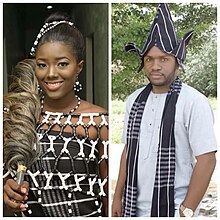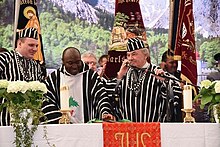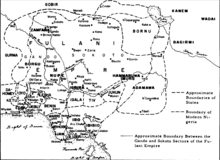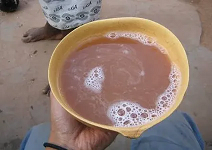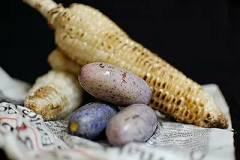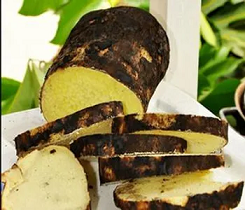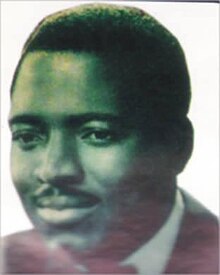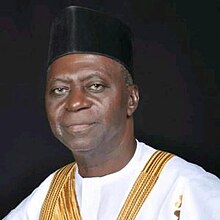
Benue State is one of the North Central states in Nigeria with a population of about 4,253,641 in the 2006 census. The state was created in 1976 among the seven states created at that time. The state derives its name from the Benue River which is the second largest river in Nigeria after the River Niger. The state borders Nasarawa State to the North; Taraba State to the East; Kogi State to the West; Enugu State to the South-West; Ebonyi and Cross-Rivers State to the South; and has an international border with Cameroon to the South-East. It is inhabited predominantly by the Tiv, Idoma, and Igede. Minority ethnic groups in Benue are Etulo, Igbo, Jukun peoples etc. Its capital is Makurdi. Benue is a rich agricultural region; common crops include oranges, mangoes, sweet potatoes, cassava, soya bean, guinea corn, flax, yams, sesame, rice, groundnuts, and palm trees.

The culture of Nigeria is shaped by Nigeria's multiple ethnic groups. The country has 527 languages, seven of which are extinct. Nigeria also has over 1,150 dialects and ethnic groups. The three largest ethnic groups are the Hausas that are predominantly in the north, the Yorubas who predominate in the southwest, and the Igbos in the southeast. There are many other ethnic groups with sizeable populations across the different parts of the country. The Kanuri people are located in the northeast part of Nigeria, the Tiv people of north central and the Efik-Ibibio are in the south South. The Bini people are most frequent in the region between Yorubaland and Igboland.
Tiv is a Tivoid language spoken in some states in North Central Nigeria, with some speakers in Cameroon. It had over 4.6 million speakers in 2020. The largest population of Tiv speakers are found in Benue state in Nigeria. The language is also widely spoken in some Nigerian states namely, Plateau, Taraba, Nasarawa, Cross River, Adamawa, Kaduna, and Abuja. It is by far the largest of the Tivoid languages, a group of languages belonging to the Southern Bantoid languages
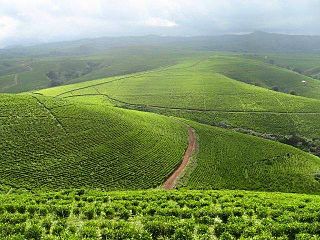
Taraba State is a state in north-eastern Nigeria, named after the Taraba River, which traverses the Southern part of the state. Taraba State capital is Jalingo. Its slogan is Nature's Gift to the Nation. The main ethnic groups are the Mumuye, Mambilla, Jukun, Kuteb, Wurkun, Yandang, Ndola, Itchen, Jenjo, Tiv,Fulani,Tigun,And Jibu. The northern part is mainly dominated by the Fulani, and mumuye. The southern parts are dominated by the Jukun, Chamba, Tiv, Kuteb and Ichen.The central region is mainly occupied by Fulani Mambilla, Ndola, Tigun, Jibu, Wurbo,And Daka. There are 77 distinct ethnic groups, and their languages in the State.
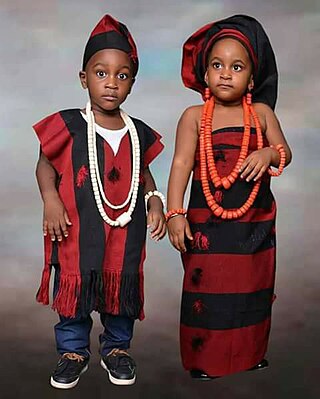
The Idomas are people that primarily inhabit the lower western areas of Benue State, Nigeria, and some of them can be found in Taraba State, Cross Rivers State, Enugu State, Kogi State and Nasarawa State in Nigeria. The Idoma language is classified in the Akweya subgroup of the Idomoid languages of the Volta–Niger family, which include Igede, Alago, Agatu, Etulo, Ete, Akweya (Akpa) and Yala languages of Benue, Nasarawa, Kogi, Enugu, and Northern Cross River states. The Akweya subgroup is closely related to the Yatye-Akpa sub-group. The bulk of the territory is inland, south of river Benue, some seventy-two kilometres east of its confluence with River Niger. The Idoma tribe are known to be 'warriors' and 'hunters' of class, but hospitable and peace-loving. The greater part of Idoma land remained largely unknown to the West until the 1920s, leaving much of the colourful traditional culture of the Idoma intact. The population of the Idomas is estimated to be about 3.5 million. The Idoma people have a traditional ruler called the Och'Idoma who is the head of the Idoma Area Traditional Council. This was introduced by the British. Each community has its own traditional chief such as the former Ad'Ogbadibo of Orokam, Late Chief D.E Enenche. The Palace of the Och'Idoma is located at Otukpo, Benue State. The present Och'Idoma, HRM, Elaigwu Odogbo John, the 5th Och'Idoma of the Idoma People was installed on the 30th of June, 2022 following the passing of his Predecessor HRH Agabaidu Elias Ikoyi Obekpa who ruled from 1996 to October 2021. Past Och'Idomas also include: HRH, Agabaidu Edwin Ogbu, who reigned from 1996 to 1997, HRH, Abraham Ajene Okpabi of Igede descent who ruled from 1960 to 1995 and HRH, Agabaidu Ogiri Oko whose reign took place between 1948 and 1959.

Jukun are an ethno-linguistic group or ethnic nation in West Africa. The Jukun are traditionally located in Taraba, Benue, Nasarawa, Plateau, Adamawa, Bauchi and Gombe States in Nigeria and parts of northwestern Cameroon. They are descendants of the people of Kwararafa. Most of the tribes in the north central of Nigeria trace their origin to the Jukun people and are related in one way or the other to the Jukuns. Until the coming of both Christianity and Islam, the Jukun people were followers of their own traditional religions. Most of the tribes, Alago, Agatu, Rendere, Goemai in Shendam, and others left Kwararafa when it disintegrated as a result of a power tussle. The Jukuns are divided into two major groups; the Jukun Wanu and Jukun Wapa. The Jukun Wanu are fishermen residing along the banks of the river Benue and Niger where they run through Taraba State, Benue State and Nasarawa State. The Wukari Federation, headed by the Aku Uka of Wukari, is now the main centre of the Jukun people.
Katsina-Ala is a Local Government Area (LGA) of Benue State, Nigeria. Its headquarters are in the town of Katsina-Ala where the A344 highway starts. It is also the location of an important archeological site where artifacts of the Nok culture have been found.
Spheres of exchange is a heuristic tool for analyzing trading restrictions within societies that are communally governed and where resources are communally available. Goods and services of specific types are relegated to distinct value categories, and moral sanctions are invoked to prevent exchange between spheres. It is a classic topic in economic anthropology.
Lt. Colonel Joseph Iorshagher Akaagerger was the Military Administrator of Katsina State, Nigeria from August 1998 to 29 May 1999. After the return to democracy, in April 2007 he was elected to the Senate representing Benue North East.
Lawrence Anebi Onoja was the military governor of Plateau State, Nigeria from 1986 to July 1988 and then of Katsina State until December 1989 during the military regime of General Ibrahim Babangida. He later became Principal Staff Officer to General Sani Abacha, before being arrested for alleged involvement in a coup attempt. He retired from the army in 1998, and after the return to democracy in May 1999 with the Nigerian Fourth Republic entered into politics.
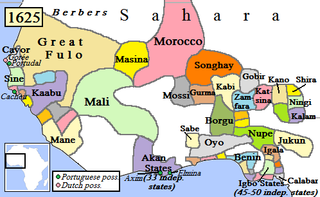
Nigerian traditional rulers often derive their titles from the rulers of independent states or communities that existed before the formation of modern Nigeria. Although they do not have formal political power, in many cases they continue to command respect from their people and have considerable influence in their community.
The Wukari Federation is a traditional state in Nigeria, a successor to the Kwararafa state of the Jukun people. The state is based in the town of Wukari in Taraba State, in the south of the Benue River basin. The ruler takes the title "Aku Uka".

The Kuteb people are an ethno-linguistic group in West Africa, who speak Kuteb, a Jukunoid language. Most of the Kuteb people reside in Taraba State, Nigeria.
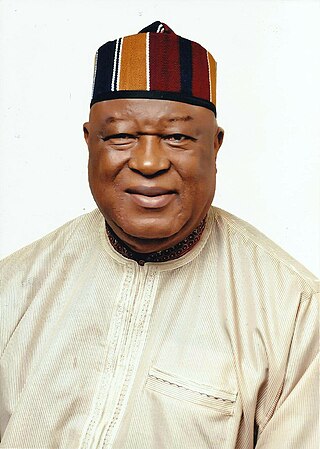
Barnabas Andyar Iyorhyer Gemade is a Nigerian politician, formerly National Chairman of the People's Democratic Party (PDP), who was elected Senator for the Benue North East constituency of Benue State, Nigeria on 9 April 2011 national elections. He is currently a member of All Progressive Congress (APC)
His Royal Majesty, Begha U Tiv, Orchivirigh Dr. Alfred Akawe Torkula, was the fourth Tor Tiv, the supreme ruler of the Tiv people and Chairman of the Benue State Council of Traditional Rulers. He ascended the throne on the principle of rotation (ya na angbian) among the two sons of Tiv, Ichongu and Ipusu. He was a Ihyarev man and son of Ichongo, and became the 2nd Tor Tiv to have come from the Ichongo extraction. He ruled from 14 January 1991 to 22 November 2015.
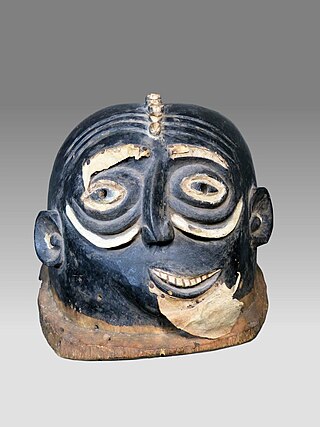
Kwagh-hir is a multipart culturally edifying art form of the Tiv people of central Nigeria which became popular in the 1960s. It is a dramatic public performance telling moral stories of past and current events, and incorporates puppetry, masquerading, poetry, music, dance and animated narratives to portray its moral themes. It is used by the Tiv people to reinforce traditional beliefs and convey other worldly tales to educate, socialize, provide secular entertainment and address societal issues.

Iyorwuese Harry Hagher, is a Nigerian professor of theatre for development, playwright, poet, politician administrator and activist for social justice. He was a senator, cabinet minister, envoy and pro-chancellor of Afe Babalola University. He is renowned for his groundbreaking research on Kwagh-Hir theatre, which was inscribed on the UNESCO Intangible Cultural Heritage Lists in 2019. Hagher is passionate about the issue of leadership. His plays are preoccupied with the search for true leadership and other solutions to Africa's socio-political problems. He is known to have engaged cultural diplomacy as a tool for foreign relations while serving as Nigeria's Ambassador to Mexico, and later High Commissioner to Canada. In 2019, he was a presidential aspirant, under the platform of the Social Democratic Party (SDP). He is currently the president, African Leadership Institute, Dayton, Ohio, United States.
The 2003 Benue State gubernatorial election occurred on April 19, 2003. Incumbent Governor, PDP's George Akume won election for a second term, defeating ANPP's Paul Unongo and two other candidates.
The 1999 Benue State gubernatorial election occurred in Nigeria on January 9, 1999. The PDP nominee George Akume won the election, defeating the APP candidate.

The 2023 Nigerian Senate elections in Benue State will be held on 25 February 2023, to elect the 3 federal Senators from Benue State, one from each of the state's three senatorial districts. The elections will coincide with the 2023 presidential election, as well as other elections to the Senate and elections to the House of Representatives; with state elections being held two weeks later. Primaries were held between 4 April and 9 June 2022.

